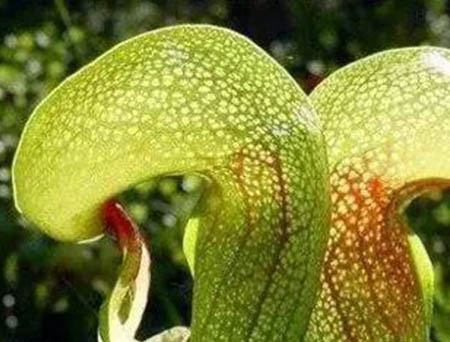How to grow Cobra Sarracenia
Written by Maggie
Nov 12 2020

Cobra Sarracenia is a genus of the Sarracenia family, an insectivorous plant, mainly distributed in northern California and Oregon. The left and right sides of their bottle caps are glued together to form a spherical top, making the entire insect trap almost sealed. There is a concave gap between the spherical cap and the bottle body. There are many white spots on the bottle cap and body that lack chlorophyll, and sunlight can penetrate these white spots into the insect trap bottle. Insects (mostly ants) can enter the trap bottle through the slit. Once inside, they will be confused by these leukoplakia, mistakenly thinking that the leukoplakia is an exit and get lost in the trap bottle, and finally fall into the digestive juice and be digested.
Cobra Sarracenia Picture

Cultivation method of Cobra Sarracenia
1. Matrix
Peat, sand, sphagnum, peat, perlite, coconut shell, etc.
2. Watering
Cobra Sarracenia needs to use soft water for irrigation, such as rainwater, distilled water, reverse osmosis deionized water, etc. Tap water in some areas contains a lot of minerals (especially calcium salts). These calcium salts will deposit and kill plants. This is because most carnivorous plants have adapted to poor acid soil, so Cobra Sarracenia is extremely calcium avoiding plants, so they are very sensitive to the nutrients in the soil.
3.Temperature
Cobra Sarracenia is resistant to cold and heat, especially the roots must be kept cold, and there must be a large temperature difference between day and night; Cobra Sarracenia can survive between minus 10 degrees and 30 degrees, and 15 to 27 degrees is the most suitable temperature for growth. Like strong light, under the circumstance that the temperature is not too high, Cobra Sarracenia can be exposed to sunlight, and the top of the plant will show a red net pattern, which is very beautiful.
4.Pests and diseases
Cobra Sarracenia is Easily attacked by aphids or mealybugs. Smaller hazards should be removed manually, and for larger hazards, pesticides should be used as appropriate. Isopropyl alcohol is an effective insecticide against scale insects. Diazinon is also a broad-spectrum insecticide that most insectivorous plants can tolerate. Malathion and acephate are also suitable for carnivorous plants.
Although pests are a problem, the biggest problem is gray mold. It develops in a warm and humid environment and becomes a serious problem in winter. Place Cobra Sarracenia in a cool, well-ventilated environment, and remove the diseased branches in time, which can inhibit the development of gray mold to a certain extent. If it fails, a fungicide should be used as appropriate.

Latest Updated
- Benefits of Bugleweed - 7 Science-backed Health Benefits
- Bugleweed Dangers & Side Effects - Is It Poisonous?
- How to Plant Evergreen Trees - What You Should Know
- When to Plant Evergreens - Grow Guide for Evergreen Trees
- 12 Wonderful Evergreen Shrubs for Your Garden
- 12 Popular Evergreen Plants with Pictures for Beginners
- When And How To Prune A Lilac Bush Like a Pro
- How to Grow & Care for Lilac Vine (Hardenbergia Violacea)
- Japanese Lilac Tree (Syringa Reticulata) Care & Propagation Guide
- Shumard Oak Pros and Cons - What to Know
Popular Articles
- Winter maintenance of Antirrhinum Majus
- How to Grow Terminalia Mantaly Tree
- How to Grow and Care for Crossostephium Chinense
- How to grow Antirrhinum Majus in spring
- Peristeria Elata (Dove Orchid) Profile: Info & Care Guide
- Underwatered Snake Plant (Sansevieria Trifasciata) - Signs And How To Fix
- How to Care for Brazilian Jasmine Plant (Mandevilla Sanderi)
- How to Grow & Care for Graptopetalum Purple Delight in Summer
- Rosa Chinensis (China Rose): Plant Growing & Care Tips
- How to Care for Baby Sun Rose (Aptenia Cordifolia)